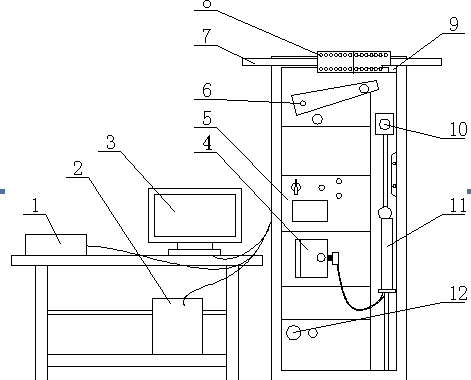
Definition and Test Procedure of Fiber Strength
Cotton fiber is a textile raw material, and fiber strength is an important indicator. Since fiber materials are often processed into high-strength threads and ropes, the strength of fiber materials is an important determinant of their performance. The strength of fiber can directly affect the quality and performance of products such as fabrics and composite materials. Therefore, in the production of fiber products, it is very important to measure the fiber strength to ensure the quality and reliability of the product.
Contents
Definition
The force of a fiber is also called absolute force or breaking force. Breaking force is the force required when the fiber material is stretched to break by the outside world (the maximum external force that the fiber can withstand). The basic unit is Newton (N), and the derived units are centinewton (cN), millinewton (mN), kilonewton (kN), etc. The readings measured on various strength testers are all forces. For example, the breaking force of a single fiber and a bundle of fibers are the forces required to stretch a fiber and a bundle of fibers to break, respectively. Breaking force is related to the thickness of the fiber, so the breaking force of fibers of different thicknesses lacks comparability.
The force required to break a fiber of unit fineness is called strength. This index is used to compare the tensile breaking properties of fibers of different thicknesses. When the fiber or yarn thickness is different, its breaking force is also different, so the breaking force of fibers or yarns of different thicknesses is not comparable. For the convenience of comparison, the breaking force can be converted into the force at the specified thickness, that is, the breaking strength. Due to the different standard thicknesses, there are many kinds of strength of fiber materials, and the most commonly used are the following three.
Fracture stress
Fracture stress refers to the maximum tensile force that the fiber can withstand on a unit cross-section area, and the unit is N/mm² (namely the megapascals, MPa). Its calculation formula is as follows:

Where: σ-fracture stress of fiber, MPa;
P – breaking force of fiber, N;
s – cross-sectional area of the fiber, mm².
Because the cross-section shape of textile fibers and yarns is very irregular, and there are many cavities, voids and gaps, its true cross-section is difficult to measure, so in daily production, this index is not used much.
Breaking strength
Strength refers to the maximum tensile force (also known as specific strength, relative strength) that the fiber can withstand per tert (or per denier), and the unit is N/tex (or N/ denier). The calculation formula is as follows:

Where : Ptex — linear density system strength, N/tex;
Pden – denier strength, N/ denier;
P – breaking force of fiber, N;
Tt — linear density of fiber, tex;
D — the density of the fibers, denier.
Breaking length
A single fiber or yarn continues for a long time, holding the upper end, when the total length of the fiber or yarn hanging under the grip point pulls the fiber or yarn itself along the grip point (that is, gravity equals strength), this length is the breaking length. The fracture length is generally expressed as L in kilometers (km). In production practice, the breaking length of fiber or yarn is determined not by suspension method, but by strength. The formula is as follows::

Where: L — the breaking length of the fiber, km;
P –breaking force of fiber, N;
g — acceleration of gravity,9.8m/s²;
Tt — linear density of fiber, tex.
Fiber strength test procedure
1. Prepare the sample: cut the cotton fiber into a certain length sample according to the standard requirements, and record the quality of the sample.
2. Installation equipment: Fix the sample holding device on the tester, adjust the instrument parameters and calibrate.
3. Test: Clamp the fiber sample on the test fixture to ensure that the sample is evenly stressed, and then start to apply tension.
4. Record data: At the moment of fiber fracture, record the maximum tension value at this time, and stop loading.
5. Calculation result: The fiber strength is calculated according to the formula, and the final result is obtained by unit conversion.
Maintenance of KX101 fiber strength tester
Pressley Fibre Strength Tester is used to determine the breaking strength of cotton fibers in a flat bundle , Associated with JN-B torsion Balance ,It is also be used to determine the breaking tenacity of cotton fibers in the flat Bundle .
- Pressley clamp production process:
- The Pressley clamps adopt blackening surfaces process during the production, so it has only a certain anti-rust ability. It will rust if stored for a long time in a high humidity environment.
- In addition, due to the hardness requirements of the design and production process of Pressley clamp (jaw hardness 55-58), stainless steel or other conventional anti-rust materials cannot be used.
- Pressley clamp rust treatment:
Please use fine sandpaper of 800 meshes or above to polish the rust gently and wipe it clean with dry soft cloth.
- Clamp vice rust treatment:
The clamp vice handle rust can be polished with the find sand paper, and smear a little grease around the handle.
- Storage method for pressley clamp:
- For a short time storage: Wipe with a dry soft cloth and put it into a zip lock bag for storage;
- For long-term storage, blows dry the clamp with a hair dryer and sealed it in a zip lock bag for storage.
NOTE: Do not apply oily rust inhibitors. The jaw faces of Pressley clamp adopt leather. Once oil is stained, it will affect the strength and elongation test results in the experiment.
- Leather faces maintenance:
If found there are grooves on the leather face, it must be replaced. Remove the old leather from the gripper and clean its surface. Be careful use fine sandpaper of 800 meshes or above to clean the face gently. Attach a little adhesive to the surface of the clamp and place a new leather pad. Put a piece of paper on the leather pad and lock the clamp. Use a sharp knife to cut off all exposed leather and leave the clamp on for 24 hours.
- If encounter mechanical failure, please contact the producer for help; Don’t disassemble the machine without permission


